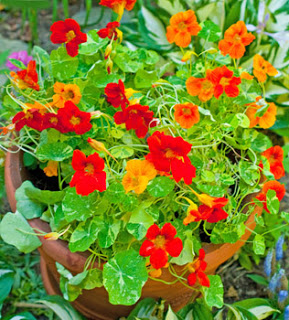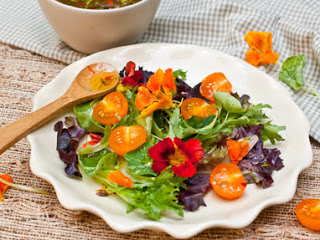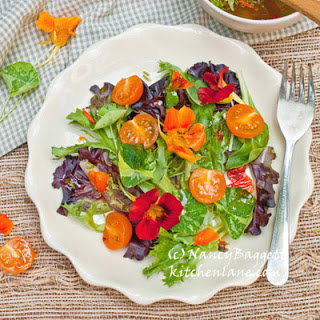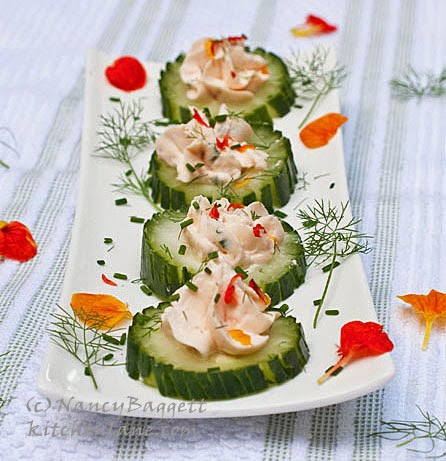I’m pleased to tell you I just ate this nasturtium salad for lunch. (It was dressed with a homemade nasturtium vinaigrette.) Yes, it was almost, but not quite, too pretty to eat. And, no, it didn’t fill me up! But it was enormously gratifying in other ways.
 I’d been carefully tending and hungrily eyeing the huge pot of nasturtiums by my front steps for some time. But because they seemed a supremely inviting entryway accent, I’ve been putting off harvesting quite a while. (I’ve read that Monet also felt nasturtiums were especially welcoming; he planted them abundantly along the path to his front door.)
I’d been carefully tending and hungrily eyeing the huge pot of nasturtiums by my front steps for some time. But because they seemed a supremely inviting entryway accent, I’ve been putting off harvesting quite a while. (I’ve read that Monet also felt nasturtiums were especially welcoming; he planted them abundantly along the path to his front door.)
Today, I finally took the scissors to my crop, and other than being a little sorry about the heavily pruned (make that shaved) look of the plants, I am glad I did. Eating nasturtium leaves and blooms strewn over a pristinely fresh mesclun is a treat I generally enjoy only at a favorite restaurant and at each summer’s end when I finally decide to turn some of my handsomest suburban yard décor into food.
Besides being delectable, these floral “greens” seems indulgent, whimsical, and oh-so-gourmet. The flavor of both the leaves and blooms is bright, lively, and herbal (yes, nasturtiums are classified as herbs as well as flowers), with delightful hits reminiscent of watercress, radish, and mustard. Note that although nasturtiums taste quite a bit like watercress and both are good sources of vitamins C and A, the two aren’t related.

The aroma of nasturtiums is also noticeably, pleasantly pungent, which etymologists say explains their name: Nasus means nose and tortus means twist or tweak in Latin. The nose-tingling smell was tempting me all during the photo shoot. Immediately after checking to be sure some of the images captured were usable, I sat right down and polished off the plate shown, then fixed myself another (much larger) serving!
But, of course, the novelty and the asthetics are also a great part of the appeal. Lately I’ve been happily creating a number of “au naturel” cookies, frostings, and garnishes for my Simply Sensational Cookies book that feature fresh edible flowers, fruits and herb blooms and leaves, and I have absolutely loved the natural flavor, color, and charm they can lend. Turning out a nasturtium vinaigrette and salad seems just a savory extension of the exploration already underway.
 Tossing nasturtiums and other flowers into salads is “in” right now, but it’s not a new idea, as this recipe translated from an 1864 Turkish cookbook, Turabi Ejendi, reveals: “Put a plate of flowers of the Nasturtium in a salad bowl, with a tablespoonful of chopped chervil; sprinkle over with your fingers half a teaspoonful of salt, two or three tablespoonsful of olive oil, and the juice of a lemon; turn the salad in the bowl with a spoon and a fork until well mixed, and serve.” It sounds quite good—and not unlike the salad served up in this post except that the vinaigrette is mixed right in instead of readied separately. That said, modern experts recommend using nasturtiums as accents and garnishes rather than the base of a salad; a whole bowl of them can be too zippy and hard to digest.
Tossing nasturtiums and other flowers into salads is “in” right now, but it’s not a new idea, as this recipe translated from an 1864 Turkish cookbook, Turabi Ejendi, reveals: “Put a plate of flowers of the Nasturtium in a salad bowl, with a tablespoonful of chopped chervil; sprinkle over with your fingers half a teaspoonful of salt, two or three tablespoonsful of olive oil, and the juice of a lemon; turn the salad in the bowl with a spoon and a fork until well mixed, and serve.” It sounds quite good—and not unlike the salad served up in this post except that the vinaigrette is mixed right in instead of readied separately. That said, modern experts recommend using nasturtiums as accents and garnishes rather than the base of a salad; a whole bowl of them can be too zippy and hard to digest.
While nasturtiums are now widely popular as ornamentals and edibles in European and North American gardens, they are native to South America and were likely introduced to the rest of the world by the conquistadors. They are tender and shrivel at the first nip in the fall air, so I make sure to shear off all the last leaves and blooms even before I start harvesting the last basil in the garden. Supposedly the unripe nasturtium buds and seeds can be preserved in vinegar and used as a substitute for capers, but I’ve never tried it.
will gradually fade over several hours, so this lightly-flavored vinaigrette will be most colorful if served shortly after being made.
However, it will keep well for 4 or 5 days in the refrigerator. In this case, bring it to room temperature (so the olive oil can become fluid again) before
serving.
you have only a few blooms and need to reserve them for the salad. The dressing
just won’t be quite as colorful.
chives, sugar, mustard, salt and pepper. Continue whisking until the salt is
completely dissolved. Gradually whisk in the oil until all is incorporated; use
7 tablespoons for a slightly milder dressing. Taste and add more salt and
pepper if desired. Let the vinaigrette stand a few minutes at room temperature
before serving to allow the flavors to mingle. Whisk, stir vigorously, or put in
a cruet or jar and shake well to blend before adding to whatever greens,
vegetables, and accenting nasturtiums you desire. Add the dressing, toss, and
serve immediately or serve individual salad plates and allow diners to drizzle
on dressing to taste. Makes 2/3 cup vinaigrette.





I’d keep in the fridge a couple days–maybe 3 or 4 at most. N
Hello
Can this be bottled? Is giw long can I use it for if refrigerated.
I just made this and bottled it.
Great recipe!
The nasturtiums can be picked and kept with their stems in water in the fridge for several days. The greens can be kept in big baggies or in a salad keeper. I wouldn't put them all together until a few minutes before serving. And add the dressing at the last minute. (You can make the dressing a couple days ahead and it will be fine, refrigerated.)
does it keep in fridge for awhile?
Jacqui, I hear that the seeds can be pickled and will taste like capers, but I've never tried this. I have saved and planted the seeds several times–that works pretty well.
I just love them in my salad, your salad is stunning…love the plant the flowers and the leaves in salads, i bottle the seeds as well Yummy
What a fantastically colourful salad.
Jamie, if I were there I'd definitely do a story on the edible flower growers. Not anybody growing them commercially that I know of around here. I'm going to post on how to decorate with edible flowers soon, btw.
And so pretty! But it is that vinaigrette that really caught my eye! Very cool about the old cookbook – nothing is really new, is it? I really haven't had much of a chance to eat fresh flowers and I am intrigued. Someone recently told me that our region around Nantes is one of the largest producers/growers of edible flowers! I must look for them on the market!
Toby, many flowers aren't edible, so don't start nibbling on just any old blooms! Nasturtiums, pinks, carnations, roses, pansies and violets are all edible, as are the blooms of most herbs.
I had no idea the flowers blooming in a pot on my patio were edible. What a lovely salad accent for color and fragrance. Can't wait to try this!
Joyce, I don't know that conquistadors ate them–maybe they took back seeds because they liked the flowers! They took cocoa beans back too–they were definitely for eating (well for making hot chocolate actually. Crhnshi, good luck on that getting your granddaughter to eat salad!
Okay, absolutely have to try this! Maybe it will be a good way to get my little granddaughter to eat salad! It looks like a salad made for fairies and sprites like her!
Joyce Braga A beautiful flower with a fascinating history. I’ll need to borrow a cup of them from a neighbor to make this salad. I love the idea of a conquistador nibbling one.
I love the idea of flowers as food. Beautiful and edible! You are so cleverly teaching us how to use flowers this way. And making it so lovely, at the same time.
Beautiful–and tempting. I'd have to steal some nasturtiums to make the salad. I don't have a lot of basil to harvest this year because a bunny mowed down half of it. I guess I'm lucky I still have HALF.
Gorgeous! I'm going to be brave enough to try this. I'm always looking for ways to make my salads a little different or special.
Lovely. A feast for the eyes as well as the palate.